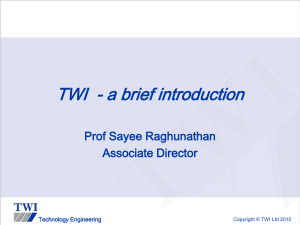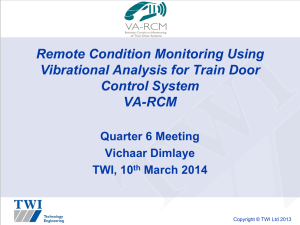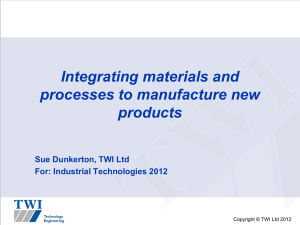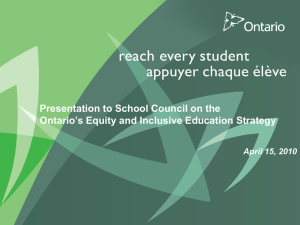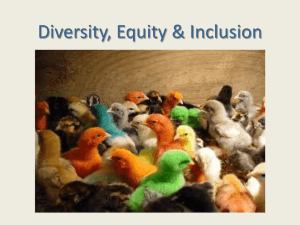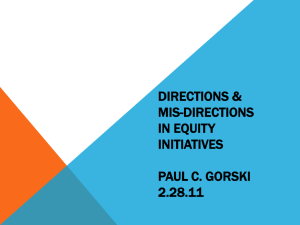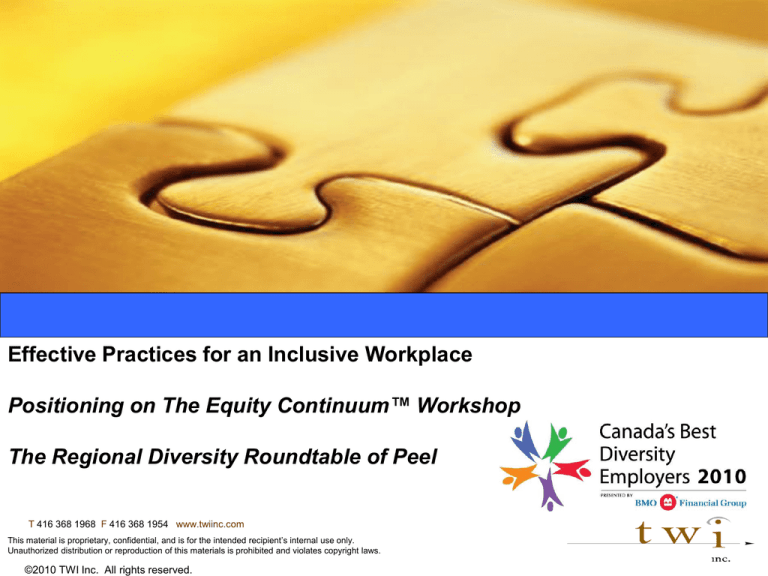
Effective Practices for an Inclusive Workplace
Positioning on The Equity Continuum™ Workshop
The Regional Diversity Roundtable of Peel
T 416 368 1968 F 416 368 1954 www.twiinc.com
This material is proprietary, confidential, and is for the intended recipient’s internal use only.
Unauthorized distribution or reproduction of this materials is prohibited and violates copyright laws.
©2010 TWI Inc. All rights reserved.
Objectives
Identify effective practices from Canada’s Best
Diversity Employers and Peel to assist in creating a
more inclusive organization
Outline the principles for successful implementation
of an inclusive workplace strategy
Provide insight into the essential role of leadership in
creating an inclusive and equitable environment.
Walk through an interactive exercise to identify key
strategic issues for effective implementation of
diversity and inclusion.
©2010 TWI Inc. All rights reserved.
The Principles
►
Equity is not equality
►
This is about organizational effectiveness not just the right thing to
do (W.I.I.F.M)
►
Representation is only one way to measure success
►
No group has a monopoly on bias or discrimination
►
Actions speak louder than words
►
Equity for All
3
©2010 TWI Inc. All rights reserved.
Principle # 1
©2010 TWI Inc. All rights reserved.
Equality vs Equity
Equality = sameness
When we treat people equally,
we ignore differences.
Equity = fairness
When we treat people equitably,
we recognize differences.
©2010 TWI Inc. All rights reserved.
Diversity
“Acknowledging any difference that can impact
on the fair or equitable treatment of people,
such as gender, race, age, ethno-cultural
background, sexual orientation, disability,
religion, education, class, marital status, family
status, etc...”
©2010 TWI Inc. All rights reserved.
Inclusiveness…
►
Inclusiveness is about creating a climate where diversity
is valued
►
In an inclusive environment each person is recognized
and developed, and their talents are routinely tapped
into
►
In an inclusive organization people are valued because
of, not in spite of, their differences
►
An inclusive environment is equitable for all
©2010 TWI Inc. All rights reserved.
Create a Climate of Inclusiveness
Do we have a climate of inclusiveness for our
clients and community representatives in our
organization?
A climate where people feel valued, respected, and
included across all of their differences.
A place where talented people choose to work and a
place where community representatives feel they have
“a place at the organizational table” that matters.
©2010 TWI Inc. All rights reserved.
Principle # 2
©2010 TWI Inc. All rights reserved.
The Equity Continuum© (1995 - 2010)
Employment
Equity
0
Denial
Corporate Social
Responsibility
1
Compliance
2
Moving
Beyond
Compliance
Diversity
Inclusion
3
The
Business
Case
Human Equity©
4
Integrated
Diversity
Employer & Supplier of Choice for All
Source: Wilson, T. Diversity at Work: The Business Case for Equity, Toronto: John Wiley&Sons, 1996
©2010 TWI Inc. All rights reserved.
5
Inclusive and
Equitable
Organizations
Factors Driving Strategic Integration of Diversity
Aging Population
Immigration
Diverse client base
Diverse talent pool
Globalization
Technology
©2010 TWI Inc. All rights reserved.
Principle # 3
©2010 TWI Inc. All rights reserved.
Proper Measurement
20%
5%
Inclusive
Environment
Internal Qualitative
External Qualitative
Internal Quantitative
Performance Management
65%
10%
©2010 TWI Inc. All rights reserved.
Principle # 4
©2010 TWI Inc. All rights reserved.
The Implicit Association Test
To take the Implicit Association Test,
go to: https://implicit.harvard.edu
To better understand how the test works and your results,
go to: https://implicit.harvard.edu/implicit/demo/faqs.html
©2010 TWI Inc. All rights reserved.
Principle # 5
©2010 TWI Inc. All rights reserved.
The Equitable Competencies
1.
Accommodation
2.
Dignity and Respect
3.
Openness to Difference
4.
Equitable Opportunity
5.
Commitment to Diversity
6.
Knowledge of Diversity
7.
Change Management
8.
Ethics and Integrity
©2010 TWI Inc. All rights reserved.
ELA Highest 10% vs. TWI Norm
5.00
4.50
4.00
3.50
3.00
2.50
2.00
1.50
1.00
Accommodation
Change
M anagement
Commitment to
Diversity
Dignity and
Respect
Equitable
Opportunity
Ethics and
Integrity
Knowledge of
Diversity
Deloitte Self Norm
3.93
3.93
4.20
3.90
3.90
4.16
3.90
3.50
Deloitte Colleague Norm
4.34
4.36
4.44
4.63
4.47
4.53
4.10
4.32
TWI Self Norm
4.09
3.58
3.62
4.27
4.36
4.26
3.26
3.68
TWI Colleague Norm
4.00
3.97
3.87
4.31
4.21
4.14
3.85
3.92
©2010 TWI Inc. All rights reserved.
Openness to
Difference
The Boss-Holes
Those who persistently leave others demeaned,
disrespected and de-motivated.
Those who have a persistent pattern of contempt for
those with less status and power.
Once identified can allow the organization to
calculate the hard and soft costs of this behaviour
e.g. outreach, replacement, retention, time spent on
complaints by supervisors, HR, legal council,
overtime, client/customer/stakeholder relationships
* Adapted from The No-Asshole Rule; Robert Sutton (2007)
©2010 TWI Inc. All rights reserved.
The Boss-Hole Dirty Dozen*
1.
2.
3.
4.
5.
6.
7.
8.
9.
10.
11.
12.
Personal insults
Invading one’s personal territory
Uninvited physical contact
Sarcastic jokes and teasing
Withering email claims
Status slaps intended to humiliate
Rude interruptions
Two-faced attacks
Dirty looks
Treating people as if they are invisible
Threats & intimidation (verbal/non verbal)
Public shaming
* Adapted from The No-Asshole Rule; Robert Sutton (2007)
©2010 TWI Inc. All rights reserved.
Example: Bottom 10%
Competency Gaps compared to Norm
5.00
4.50
4.00
3.50
3.00
2.50
2.00
1.50
1.00
Accommodat ion
Change
M anagement
Commit ment t o
Diversit y
Dignit y and
Respect
Equit able
Opport unit y
Et hics and
Int egrit y
Knowledge of
Diversit y
Openness t o
Dif f erence
Org. X Self Scores
5.00
4.80
4.60
5.00
5.00
5.00
4.60
4.80
Org. X Rat ers Scores
3.20
2.20
2.20
3.80
3.40
3.60
2.40
2.80
TWI Self Norm
4.62
4.60
4.56
4.82
4.75
4.60
4.38
4.42
TWI Rat er Norm
3.90
3.57
3.24
4.20
4.01
4.05
3.33
3.93
©2010 TWI Inc. All rights reserved.
Principle # 6
©2010 TWI Inc. All rights reserved.
Designated Groups
Canadian:
American:
Women
Women
Visible Minorities
Minorities
Aboriginal People
People 40 & Older
Disabled Persons
Persons with Disabilities
Vietnam Veterans
©2010 TWI Inc. All rights reserved.
Who Makes Up Our Community?
►
►
►
►
►
►
►
►
►
►
►
►
Men
Young People
Married People
Divorced People
Single people with Children
Lesbians
Generation “X”
Visible Minorities
English Speaking People
Executives
Francophones
Pregnant Women
►
►
►
►
►
►
►
►
►
►
►
►
©2010 TWI Inc. All rights reserved.
Women
Older people
Single people
Married people with
children
Gay Men
The “Sandwich Generation”
White people
People with Disabilities
Transgendered
Managers
Aboriginals
White Able-Bodied Males
The Eight Questions that Matter
1.
We have a clear vision of our ideal work environment that incorporates
equity and inclusion.
2.
We have a compelling business case for diversity
3.
Leaders understand, support and regularly communicate the business
case.
4.
We have clearly defined goals and timetables to achieve an equitable
and inclusive work environment.
5.
We have qualitative and quantitative organizational data to
understand our current work environment.
6.
We have strategies and a well defined roadmap to achieve our goals.
7.
We do have an integrated measurement process that uses our human
resources and organizational review practices to “prove” our business
case.
8.
We have an infrastructure to support our equity and inclusion strategies
©2010 TWI Inc. All rights reserved.
TES Scorecard: Overview
3.14
3.08
Vision
3.44
3.58
Business Case
2.80
2.92
Leadership
2.61
Goals
Data
2.94
Roadmap
2.80
2.92
3.33
2.52
2.58
Measurement
2.97
Infrastructure
3.42
0
1
2
26
©2010 TWI Inc. All rights reserved.
TWI Norm
Your Org.
2.17
3
4
5
The Equity Continuum™ Scorecard (TES)
Range Scores
Minimum Score
Maximum Score
Average
Consensus
Index*
Vision
.882
Business Case
.979
Leadership
.826
Goals
.882
Data
.725
Roadmap
.781
Measurement
.669
Infrastructure
.967
Continuum Score
1.013
• Higher numbers = less consensus
27
©2010 TWI Inc. All rights reserved.
The Equity Continuum™ Scorecard (TES)
Highlights
Highest Scores
Business Case: Average =
Vision: Average =
Highest Relative to TWI Norm
Lowest Scores
Roadmap: Average =
Goals: Average =
Lowest Relative to TWI Norm
Most Variability
Business Case
Infrastructure
Business Case
Data
Most Consensus Overall
Measurement
Overall EC Rating for Your Org. = 2.46 versus TWI Norm = 2.90
28
©2010 TWI Inc. All rights reserved.
The Equity Continuum™ Scorecard: Community Consultation Results
TWI Norm: Distribution of Employee Ratings
Board
2.81
TWI Norm
2.90
PWDs
1.75
Special Ed.
1.65
28%
1
2
Compliance
Unions
1.87
Parent
council
1.85
©2010 TWI Inc. All rights reserved.
21%
Moving
Beyond
Compliance
33%
18%
3
4
The
Business
Case
Integrated
Diversity
2%
5
Leaders in
Diversity
LGBT
2.8
Aboriginal
1.89
Immigrant
Services
2.55
2010 Winners and Scores
Agrium Inc.1.60
McGill University – 1.60
Alberta-Pacific Forest Industries Inc. – 1.25
Mount Sinai Hospital – 2.53
BC Hydro – 2.49
MTS Allstream Inc.- 2.12
Bell Aliant Regional Communications – 2.60
Nexen Inc.- 1.13
Blake, Cassels & Graydon – 2.73
Novartis Pharmaceuticals Canada Inc.- 2.07
Boeing Canada Operations Ltd.- 2.21
Ontario Public Service – 2.80
Bruce Power Limited Partnership – 1.29
Port Metro Vancouver – 1.84
Business Development Bank of Canada – 2.60
Procter & Gamble Inc. – 2.64
Cameco Corporation – 1.29
Royal Bank of Canada – 2.94
Canada Mortgage and Housing Corporation – 2.90
Saskatchewan Gaming Corporation – 1.59
Canada Safeway Limited- 2.81
Saskatchewan Government Insurance / SGI – 1.80
Canadian Food Inspection Agency-2.74
SaskPower Corporation – 2.26
Catholic Children's Aid Society of Toronto-2.48
Scotiabank Group – 2.97
Corus Entertainment Inc.- 1.80
Shell Canada Limited – 2.50
Diavik Diamond Mines Inc. – 1.56
Stantec Consulting Inc. – 2.2
Ernst & Young LLP – 3.62
Statistics Canada – 2.24
George Brown College – 2.25
Stikeman Elliott LLP – 2.11
Health Canada – 2.94
Telus Corporation – 2.87
Home Depot Canada, The – 2.95
Toronto Police Service – 2.21
HSBC Bank Canada – 3.57
TransCanada Corporation – 2.36
KPMG LLP – 3.55
University of British Columbia – 2.62
L'Oréal Canada Inc.- 1.8
University of Toronto – 2.18
Manitoba Lotteries Corporation – 2.78
©2010 TWI Inc. All rights reserved.
30
Best Practices 1’s & 2’s
1
Corporate Social
Responsibility
Moving Beyond
Compliance
Compliance
•
Motivated by compliance
•
•
Reactive
•
Focus on equality, rather than
equity
•
•
•
Stop initiatives if driving forces
change or fall away
•
•
31
©2010 TWI Inc. All rights reserved.
2
Recognize the value in going beyond
compliance
Aim to support disadvantaged groups
Stop initiatives if leadership or public interest
changes
No plan to integrate diversity into larger
organization culture
Isolated efforts, one or more diversity initiative
in place
Best Practices of the 1’s & 2’s
►
Diversity advocacy groups established
►
Meetings to advance the careers of Aboriginal and visible minority employees
►
Establishing partnerships with Aboriginal businesses and apprenticeship programs
►
Provides Blackberries to staff who are deaf to help in their communications with coworkers
►
Provides internships to disabled workers
►
Have a diversity team that meets to discuss diversity initiatives and plan awareness
activities
►
Dedicated budget for tools and services to help disabled employees in the workplace
►
Helps women employees advance their careers and addressing barriers and promotes
leadership development, mentorship and peer coaching
►
Aboriginal management program to prepare employees for senior positions
►
Recruitment strategy to become an employer of choice for Aboriginal Canadians
►
Links job postings to relevant community agencies to recruit employees from diversity
groups (inc. network to recruit and retain LGBT employees)
32
©2010 TWI Inc. All rights reserved.
Best Practices 2’s & 3’s
2
Diversity
Moving Beyond
Compliance
The Business
Case
•
Understand that diversity initiatives can improve
the organization
•
Evaluates diversity initiatives qualitatively and
quantitatively
•
Representation numbers as a means to an end rather
than the focus of the diversity strategy
•
Know initiatives can survive the loss of employee or
public interest if the business case remains valid
•
Use an inclusive definition of diversity
33
©2010 TWI Inc. All rights reserved.
3
Best Practices of the 2’s & 3’s
►
►
Employee engagement survey and scoring to obtain measurement
of perceptions of equity within the workplace by group
Session to engage executives and build a common understanding
of diversity, inclusion and inclusiveness
►
Senior Level National Diversity Council Established
►
Dedicated and separate Diversity and Inclusion Budget
►
Annual Diversity and Inclusion convention
►
Cultural awareness programs and resources, including diversity &
inclusiveness leadership program
►
Created a compelling business case for diversity and inclusiveness
►
Director of diversity and inclusiveness role created
►
Committed headcount to Diversity and Inclusion
34
©2010 TWI Inc. All rights reserved.
Best Practices of the 2’s & 3’s
►
Measurement and goals set for the percentage of employees,
managers and executives who are women and visible minorities
►
Flexible work options and programs for older employees
►
Diversity training component for all hiring managers
►
Hosts a special diversity section on corporate intranet
►
Annual Employee survey includes inclusiveness section survey
►
Diversity and inclusiveness vision published and communicated
►
Diversity Intervention Coaching
►
►
Strategy includes milestones, areas for improvement, equity metrics
and a detailed implementation plan
Audience Response Technology Focus Groups
35
©2010 TWI Inc. All rights reserved.
Best Practices 3’s & 4’s
3
Inclusion
Integrated
Diversity
The Business
Case
•
Internalized diversity as a core value
•
diversity as an essential element of continued growth
•
Integrate diversity into all aspects of the organization
•
All employees consider themselves responsible for
creating a fair and equitable environment
•
Commitment to diversity is not affected by economic
trends
•
Modify focus on diversity to ensure alignment with the
organization’s core values
•
Employers and Suppliers of Choice for all
36
©2010 TWI Inc. All rights reserved.
4
Best Practices of the 3’s & 4’s
►
Percentage of employees, managers and executives who are women and visible minorities
above LMA
►
Regularly update their equity policies, recruiting processes and training procedures to ensure
that their diversity initiatives stay current
►
Has helped other organizations develop their own diversity modules
►
Inclusive Employee Census beyond EE SIQ
►
C.O.O leads national diversity steering committee
►
Diversity initiatives include: scorecard; performance objectives; training and award
►
Exploring dynamics of cross cultural interactions to help create an inclusive and synergistic
environment
►
Attitudinal competencies Leadership Assessment
►
Behavioral competencies Leadership Assessment
►
Bias Assessment Tool for recruiters
►
Strategic Sourcing Recruitment
►
Inclusive Education Diversity Curriculum
37
©2010 TWI Inc. All rights reserved.
Best Practices of the 3’s & 4’s
►
Establishing meaningful goals beyond representation via balanced scorecard
►
Accountability measures for goals
►
Recruits for diversity by expanding traditional recruitment methods
►
Survey to measure attitudes towards diversity, diverse groups and diversity climate that
includes perceptions of harassment, discrimination and abuse of authority
►
The needs of employees and alternative work programs account for different gender, cultural,
family and religious needs. eg. family friendly benefits/flexible work options
►
Regular orientation, staff and manager training includes inclusiveness and cultural
competency
►
On-going training for diversity change agents and affinity groups
►
Annual recognition of Diversity Champions
►
Executive Sponsor Coaching
►
Two-way Diversity Mentorship Program
►
Equitable Manager Assessment and Education
►
Chief Diversity Officer position established
38
©2010 TWI Inc. All rights reserved.
Leadership Best Practices
Educating leaders to ensure they understand and can champion the business
case for diversity
Leaders have established tangible quantitative and qualitative goals based on most
recent census rates and labour force availability to 2013.
Leaders have articulated a compelling business case for diversity linked to a
specific business outcome.
Leaders have developed a written policy on diversity linked to innovation, market
share or customer satisfaction.
Leaders actively participate in diversity related organizations eg. BBPA, BLSAC,
CWF, Diversity Roundtable, LAWS, ProPRIDE, TRIEC,CEO Roundtable on
Diversity
External Diversity Advisory Committee established to guide leadership
Women in Leadership website to show role models for women's career progression
Leaders participate in two way and reverse mentorship programs
Leaders have established a comprehensive diversity and inclusion index to monitor
progress
Measurement of leadership behaviour related to diversity and inclusion
Accountability framework for leadership behaviour related to diversity and inclusion
39
©2010 TWI Inc. All rights reserved.
Imagine it is 3 years from today….
Describe your organization’s work environment.
How are people behaving differently?
What are people saying about diversity, inclusion and human equity
now?
How do leaders understand, support and communicate about diversity,
inclusion and human equity?
What goals have you reached to move towards a more equitable and
inclusive work environment?
What qualitative and quantitative data have you collected to better
understand the work environment?
What specific improvements have you made to the measurement
process to “prove” your business case?
Describe the infrastructure you have created to support your equity
and inclusion strategies
What problems has the diversity committee solved?
What specific outcomes have been achieved?
©2010 TWI Inc. All rights reserved.
Human Equity Resources
Buckingham, Marcus & Coffman, Curt, First, Break all the Rules, New York: Simon & Schuster, 1999
Buckingham, Marcus & Clifton, Donald O., Now, Discover Your Strengths, New York: The Free Press, 2001
Buford, Bob, Finishing Well, Franklin: Integrity Publishers, 2005
Buford, Bob, Half Time, Grand Rapids: Zondervan, 1997
Collins, Jim. Good to Great, New York: Harper Business, 2001
Covey, Stephen R., The 8th Habit, New York: Free Press, 2004
Csikszentmihalyi, Mihaly, Flow: The Psychology of Optimal Experience, New York: Harper & Rowe Publishers Inc,
1991
Gabarro, Thomas and John J, Breaking Through, Boston: Harvard Business School Press, 1999
Gladwell, Malcolm, Blink, New York: Little, Brown & Company, 2005
Gladwell, Malcolm, Outliers New York: Little, Brown & Company, 2009
©2010 TWI Inc. All rights reserved.
Human Equity Resources
Laney, Marti Olson, The Introvert Advantage, New York: Workman Publishing Co. Inc.,
2002
Loehr, Jim and Schwartz, Tony, The Power of Full Engagement, New York: The Free
Press, 2003
Nomura, Catherine & Waller, Julia, Unique Ability, Toronto: The Strategic Coach Inc,
1995
Pink, Daniel, Drive, Putnam Press, 2009
Sheehy, Gail, Passages, New York: Ballantine Books, 2006
Wallace, Paul, Agequake, London: Nicholas Brealey Publishing, 1999
Warren, Rick, The Purpose-Driven Life, Grand Rapids: Zondervan, 2002
Wilson, Trevor, Diversity at Work, The Business Case for Diversity. Wiley: Toronto,
1998
©2010 TWI Inc. All rights reserved.
Please stay in touch..
trevor@twiinc.com
Phone: 416-368-1968
http://ca.linkedin.com/pub/trevor-wilson/4/959/9b7
http://twitter.com.inshalla
©2010 TWI Inc. All rights reserved.

